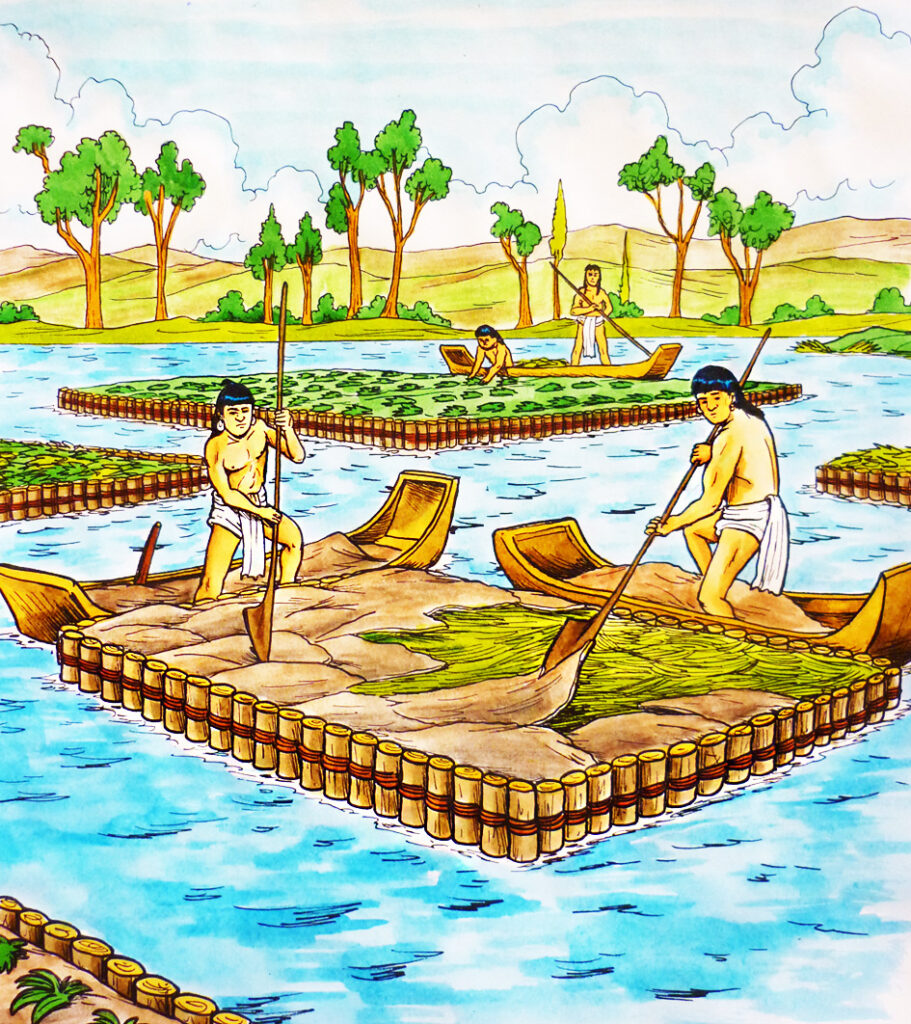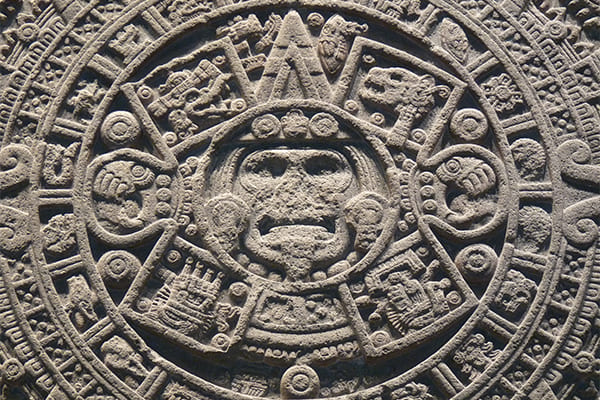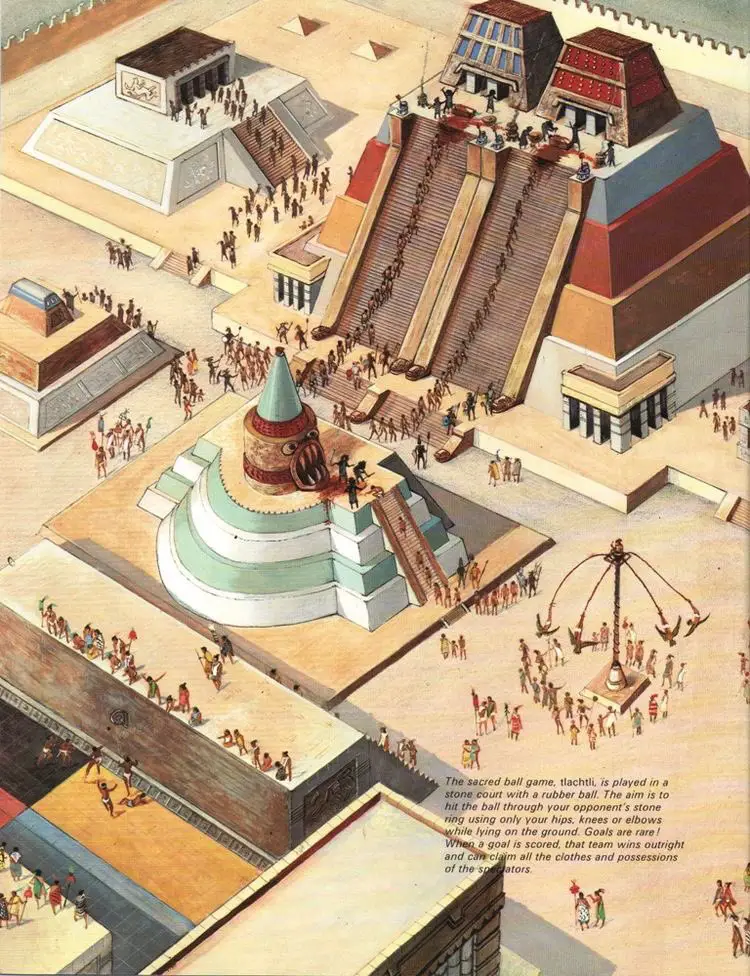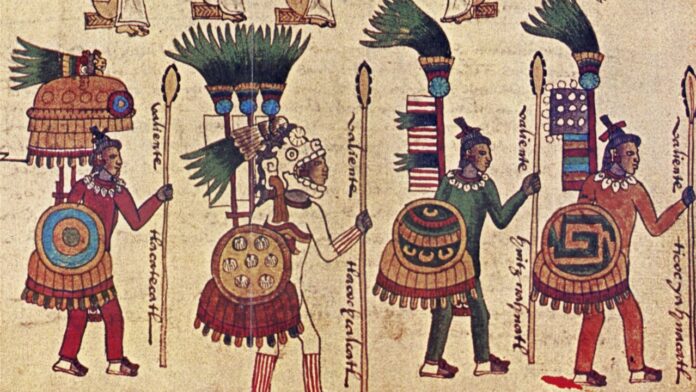The Aztecs, often associated with warfare and elaborate rituals, gave birth to a sophisticated system of government that governed vast territories, remarkable artistic endeavors, and a resilient language, Nahuatl, which over one million people in Mexico continue to speak today.
And that’s only a few of the most notable Aztec achievements.
Their mastery of intricate crafts and unique understanding of the natural world provide an intriguing glimpse into Aztec culture. Let’s dive deeper into the remarkable contributions of this influential empire.
Aztec Civilization and Its Enduring Legacy
The Aztecs, also known as the Mexica, stood as pivotal figures in the pre-Columbian Americas. Their roots trace back to the Chichimecas, a group of nomadic and semi-nomadic Indigenous peoples of northern Mexico.
In the 14th century, they migrated from Aztlan to the Valley of Mexico and established their capital city, Tenochtitlan, on an islet within Lake Texcoco. This location, now modern-day Mexico City, was once the epicenter of Aztec culture, adorned with architectural masterpieces like grand pyramids and temples.
The Aztecs’ intricate social structure empowered priests and nobles while their economy prospered from agriculture, trade, and tributes. Their spiritual depth was evident in their polytheistic practices, with grand ceremonies and human sacrifices to honor their gods. Alliances, particularly the Triple Alliance with Texcoco and Tlacopan, propelled their empire’s expansion.
Yet, in 1521 C.E., their reign met its demise at the hands of Hernán Cortés and his small army.
Despite their empire’s fall, the Aztecs’ imprint on art, science, and culture endures. Their descendants, the Nahua people, uphold many Aztec traditions, especially in Mexico’s central regions. Over a million individuals still communicate in Nahuatl, a testament to the Aztec culture’s lasting influence.
This rich heritage, from gastronomy to festivities, has woven itself into Mexico’s national fabric.

Floating Gardens
The Aztecs settled in a challenging area of the Valley of Mexico, building their big city, Tenochtitlán, on an island in the marshy Lake Texcoco.
This place, though tricky, had some advantages. Even with limited land, the Aztecs came up with innovative ways to feed the large population of Tenochtitlán, including the creation of “chinampas” or floating gardens.
They grew lots of crops on these man-made islands located in the shallow parts of the lake. Among the crops were corn, beans, and squash — often referred to as the “Three Sisters” due to their complementary growth patterns — which were crucial for feeding the city’s inhabitants. They also raised animals, such as turkeys, for food and other products.
To create these agricultural wonders, large areas were staked out in the lake to mark the desired garden’s perimeter.
Between these stakes, a mat of intertwined reeds, twigs, and branches was woven, creating a foundational base. Atop this base, they layered mud from the lakebed combined with decaying vegetation, forming a fertile soil for farming.
Willow trees were strategically planted around the chinampas’ borders, serving dual purposes: Their growing roots stabilized the garden, and their branches acted as windbreakers.
Regular maintenance ensured these remarkable agricultural plots remained productive and afloat. Human manure was used as fertilizer, which served the dual purpose of providing nutrients for the crops while keeping the city clean.

The Sacred Calendar System
The Aztec calendar system is a testament to the civilization’s intricate understanding of time and cosmology. With its foundation in Mesoamerican traditions, the calendar melded the 260-day Tonalpohualli and the 365-day Xiuhpohualli.
The Tonalpohualli, divided into 20 periods of 13 days, held profound spiritual significance, while the Xiuhpohualli aligned closely with the solar year, broken into 18 months and an additional 5 “unlucky” days. Their synchronization every 52 years marked the “Calendar Round” or “New Fire Ceremony,” symbolizing a renewal of time.
The Aztec Sun Stone, while often mistakenly termed the “Aztec Calendar,” serves as a visual representation of their timekeeping system and cosmological beliefs.
This monumental disc intricately depicts the cycles, deities, and symbols associated with their calendar. Its detailed carvings provide insights into how the Aztecs perceived time’s progression, cosmic events, and their place in the universe.

Universal Education
Education was highly valued among the Aztecs, who many believe set the stage for universal education as we know it. Children began their educational journey at home, where they learned important life skills. Girls were taught domestic chores, while boys were instructed in their fathers’ trades. To instill discipline, children were given limited amounts of food to learn self-control.
For young boys, there were additional challenges. They underwent physical hardships, including exposure to extreme temperatures, as part of their warrior training, aiming to develop a strong sense of determination.
Around the ages of 12 to 15, all Aztec children attended a school known as a cuicacalli, or “house of song.” Here, they learned ceremonial songs and the cosmology of their people. To ensure attendance, elders accompanied the children to and from school to prevent truancy.
While formal education typically concluded for most girls at age 15, boys from commoner families continued their education at a telpochcalli (a type of vocational school) until they were 20. This education was primarily focused on Aztec military training.
Sons of the nobility, however, attended a different school called calmécac. Here, they not only received military training but also delved into the humanities, including subjects like architecture, mathematics, painting, and history. The calmécac produced future priests and government officials.
Soccer
The Aztecs played a game called ollama — akin to modern soccer — on a unique field known as a tlachtli. This field had a distinctive “I” shape and towering walls about three times the height of the players. Attached near the top of these walls were stone rings representing the sunrise and sunset.

The primary objective of ollama was to propel a small rubber ball, symbolizing celestial bodies like the sun, moon, or stars, through these stone rings. Players could only use their hips, knees, or elbows to score.
Notably, ollama was initially played by the Aztecs’ predecessors, the Maya, but it gained an elevated status within Aztec society and was reserved for nobles. Despite its sporting nature, ollama could turn violent. Instead of a traditional halftime show, it involved human sacrifices, and scoring teams had the opportunity to attempt to rob spectators.
Source: “Aztec Empire.” Gale Encyclopedia of World History




